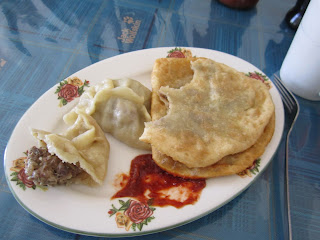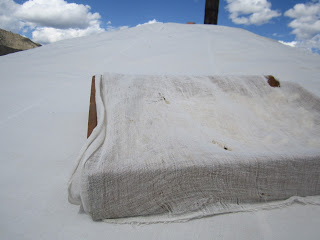A lot of people have asked, “what exactly are you doing in
Mongolia?”
In one sentence: I am conducting an international
development consult for the United Nations Food and Agriculture Office
regarding rates of return in the Mongolian Livestock Value Chain survey
embedded in a larger Strengths Weaknesses Opportunities Threats (SWOT) analysis
of the industry as part of my master’s degree.
This description causes many to ask, “OK, what exactly are
you doing in Mongolia?”
“Drinking way too much milk tea and airag.”
As part of my Master’s in Development Practice, I am
required to do an international development consult for an outside
organization. Originally, I was supposed to go back to Thailand to work on a
climate change project. Funding fell
through. So that I did not get screwed, Professor
Roland-Holst (who we affectionately refer to as DWRH) connected me with the
United Nations Food and Agriculture Office (FAO). They wanted to do an analysis
of rates of return to middle men in the Mongolian Livestock Industry, but weren’t
really sure about how to go about it, and don’t really specialize in this type
of work. DWRH had sub-contracted Berkeley grad students to do this kind of work
before in South East Asia using value chain surveys.
DWRH in Ulaanbaatar
So, I was handed a terms of reference to a project about ducks and bird flu, and told to write some kind of work agreement for myself. Never having written my own job description before, and not knowing what a value chain was until I looked it up on Wikipedia, I pretty much just ran the words
“Thailand” and “chicken” through find-and-replace so that the document read
“Mongolia” and “livestock.” I added a section on SWOT to give myself another tangible deliverable in case the quantitative survey failed miserably. According to DWRH, FAO liked this, and my project was a go.
I ended up in Ulaanbaatar on June 14 with minimal
understanding of both livestock systems, and Mongolia. I mean, I could find
Mongolia on a map, and vaguely remembered some stuff from 7th grade history about Genghis Kahn (which I now know is better pronounced as Chinngis). Thankfully, Zilbo pointed me to this classic of livestock economics:
My overall plan has been to start with the qualitative and
move to the quantitative. Many in academia seem to view these tools as somehow
at odds with each other, but really they serve complimentary functions.
Qualitative methods yield understanding, and structure to the study of a
problem. They produce concepts of how things work, and what is important.
Quantitative methods measure effects, and, when well done, provide evidence for
or against hypotheses generated by qualitative methods.
Effectively, this meant that I spent my first week doing qualitative,
unstructured interviews with NGOs in UB. From there, I flew out to Khovd to
start talking to rural people, keeping my interviews free form and informal.
That began to give me an understanding of the industry. From there, I have
developed a survey tool (using Open Data Tool Kit), for the purpose of conducting quantitative surveys, which I have been doing since Ulliastai. It’s a tad unfortunate that I am both designing and implementing the survey, because I keep changing the questions in an effort to improve the survey, but so it goes.
That’s pretty much where I am now. Going to where different actors on the value
chain and having an interpreter ask questions. And drinking lots of milk tea and airag on the way.
Going in with minimal understanding of both has actually
been an advantage. All my theories have been generated by work I’ve done, not
by preconceived notions developed in a classroom. And I’ve been too naïve to
avoid 30 hour bus rides, which has led to better data.
This has led to an understanding of the Mongolian
livestock industry, which probably makes up at least 40 percent of the country’s
employment when you combine herders, transportation and processors, that sees
choices of actors as more rational in their context, and products more
interdependent than one would think as an outsider.
The Mongolian livestock industry does face internal
weaknesses, and many outside threats. And studying the value chain has led to
an interesting understanding of the industry here in Mongolia. I’ll discuss my findings in later posts.
Naadam Horse Racing
Until then, travel safe everybody.







